


VR GIS 64
[DTM Version 64.0 released: 11 11 2011]
This page updated: July, 2011
DTM™ Digital Terrain Mapping
This program is in transition from VR GIS to VR GIS 64.. 3D viewing is moved to SOS MAP and all the data processing will remain as DTM. A Beta version has been released and Re-released in July 2011. This is as of July, 2011.
- Digital Terrain Mapping (DTM): Import Digital Elevations and display as a 2D map. The ILH Program prints the Ecotype Color Chart which requires the Borland BDE. DTM is an extension of the GL Scene Height Terrain Field (HTF) utility by Eric Grange combined with many of the other demos and ideas of mine.
- The relation between this (DTM) - Fractal 3D - and SOS MAP is continually changing, however there is an overlap in the programs functionality. Fractal 3D creates fractal landscapes and sundry other images-objects ...DTM processes sundry DEM data into HTF files...for fast access of the compressed data. SOS MAP Surreal Object Synthesis Multimedia Analysis Product performs 3D viewing for Analysis of data and Synthesis of the results into a new product. 3D views of Caves, Mines, geological depth,... are normally site specific rather than areal and would require individual data, additional processing and a 3D viewer.
- DTM is a data importer-compressor-previewer. Digital Elevation Models (DEM) provide a base for 3D surficial overviews of natural resource data. [Alt] Left autosaves a snapshot of the screen. See the programs Help..html for detailed information on functionality, procedures and processes.
- Etopo5,2,1, Gtopo, Globe, and Stopo (SRTM30 Plus) can be processed by running the (included) .tpcfg file. They take from 30 seconds to 7.5 minutes to process into a htf file. Suggested use is to place the data on a removable disk, as after processig onto a htf, it is no longer required. DTM can read the data from 1 disk and produce the htf on another. DEM data .pdf provides information about various data sources.

DTM HTF Menu

DTM 2D viewer Menu Note the need to select Elevation data and .shp overlay of the same resolution... and Projection..Datum.
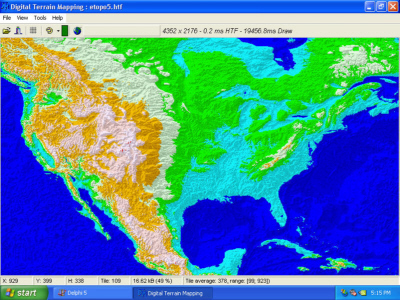
- Ecotype Colors with a Color-Data range selection form. Based on Hammes Modelling of ecosystems as a data source for real-time terrain rendering (pdf); Terrain Texture Generation By Tobias Franke, 30 April 2001 on flipcode.com. Ecotypes clustered from
Olson World Ecosystem Classes, Omernik Ecoregions, Bailey Ecoregions, US NVC, Holdridge Life Zone, Unesco, GAP, FAO, Cowardin, Anderson, et al... They use variations of Forest, Woodland, Shrubland, Dwarf-shrubland, Herbaceous, Nonvascular, Sparse Vegetation; Urban, Water, Wetland, Snow-Ice, Crop-Rangeland to classify the land - landcover - vegetation. Basically all are hierarchical systems that have base classes that become further defined. They differ in what parameters are used to determine the classification; be it Climate, Temperature, Precipitation, Hydrology, Elevation, ... or strictly the vegetation with density, height, and primary vegetation percentage. The Ecotype form is designed for multipurpose use: be it a classification legend ...to... input to a procedural method.
Images and Data Information
Coverage: NED 90,30,10M:USA, ASTER (30m: 83+-), SRTM(90m: 60+-)
GLOBAL data sets:GTOPO30 (1K: 30 Arc-Second), NOAA Globe(""), ETOPO1(2K: 1 arc-minute), ETOPO2, ETOPO5
ASTER estimated:22,600 .tif tiles makes 587G of land data : Global ~1.5T as Integers : ___htf (TBD) ...DTM CANNOT process GEOTIFF files... however HWTools can and export a binary
SRTM: CgiarV4 873 files 14.1G zipped .asc Files, ~64G as Integers. Be advised some files are 6000x6000 and some are 6001x6001- dunno why, DTM ignores the extra pixel and makes a log file for each 6001x6001 file.
(will process in - from zip files to .bii files prior to making a .htf , translating the ascii takes over 3 minutes.. creating the htf from the binary takes 2 seconds (larger areas take Longer.. not linear).. huh, 873 files would take over 2 days... maybe process in groups... then run the .tpcfg to convert them into 1 htf... well it turns out that is not possible due to htf size limitations Width x Height must be less than an Integer.
Integer: –2147483648..2147483647 : 2.14Gig)
124.416 Gig Area: ?~20G?..10?..? ___ htf
432000x144000= 62,208,000,000 , larger than 2,147,483,647
LARGEST htf possible is between 40,000 and 50,000 square
40kx40k=1.6 50kx50k=2.5
USA srtm 66kx30k=1.98Gig (45 minutes to process into a htf from bii files)
90 meter DTED dem of continental USA makes a 1.1 Gig htf file
GTOPO30: 43,200 x 21,600, 33+ 1 Antartica Polar files 301M zipped :33files:1.73G: 284M htf
STOPO30Plus 43,200 x 21,600 (with Ocean data), 33 files: 1.73G : 922M htf
NOAA Globe: 43,200 x 21,600, 16 Files : a..p : 296M zipped : 1.73G : 292M htf
etopo1_bed_g_i2.bin, 21600 by 10800, 320M zip, 455M : 242M htf
ETOPO2v2c_i2_LSB.bin, 10800 x 5400, 114M : 71M htf
ETOPO5.DOS 4320 x 2160 data values (REDONE as of 27 May 2005) 18M : 10M htf. The Etopo5 data is from 0 to 0 degrees. I have written a split and flip to make it -180..180 like all the other global datasets. Much easier to write lat-lon projection location code for -180..180.
Etopo5,2,1, Gtopo, Globe, and Stopo (SRTM30 Plus) can be processed by running the (included) .tpcfg file. They take from 30 seconds to 7.5 minutes to process into a htf file. (your times may vary on your cpu). Aster(30M), NED(30M, 10M), and srtm3(90m)-cgiarv4.1 will need to be made into htf of subset areas. o boo hoo.

Cgiar srtm3V4 subset. There is a reason it is called a Flood Plain. St Louis area of the USA.
Above image link also displays ASTER 1AS, NED 1AS, and NED 1/3AS of the same area
some of the following information is dated... things change during 30 years
dtm faq
overall DEM notes is the same text attached to world image below: Etopo5 dem Data Information.
DEM data sources and ideas ~ todo list .txt TEXT file
.tpcfg Read Me .txt Text file
.tpcfg file howto
Map Projection parameters another way
Map Projection parameters another way
Map projection parameters
Map Projection input ranges
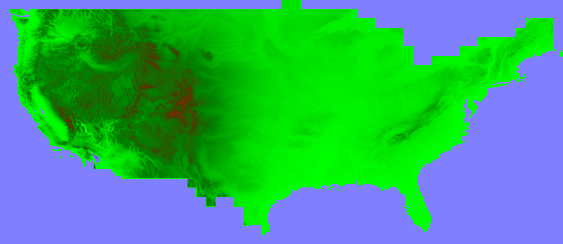
934 USA 1 Degree DEMs ~10G= 2.5G=1G
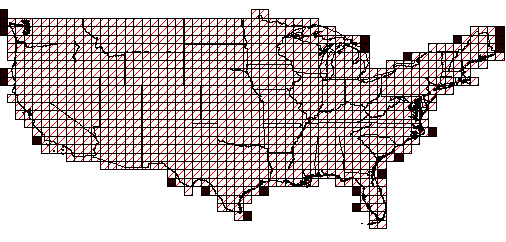
DEM cells overlay

425 Alaska 1 Degree DEMs 2G=572M=153K
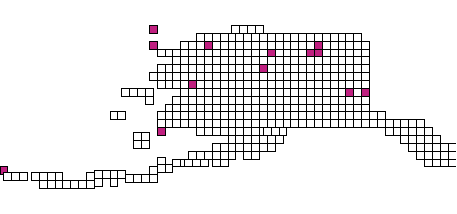
Alaskan DEM cells overlay
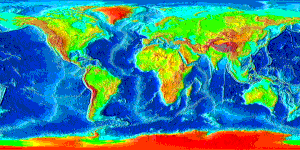
Etopo5, Gtopo, and a world gridded map

 Copyright © 1991..2011 by Ivan Lee Herring
Copyright © 1991..2011 by Ivan Lee Herring












